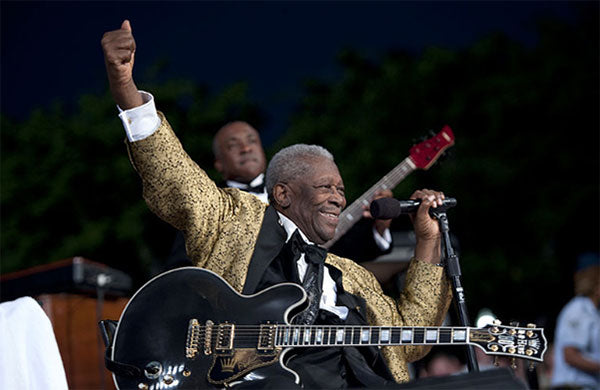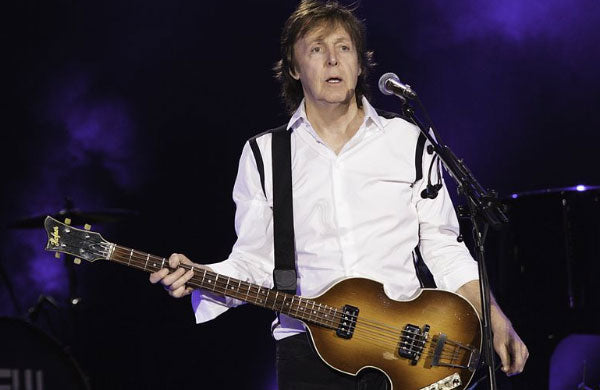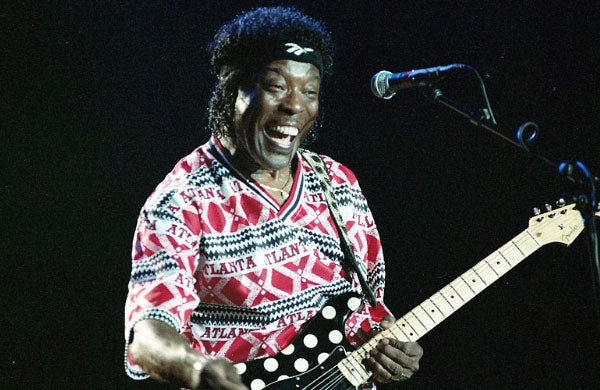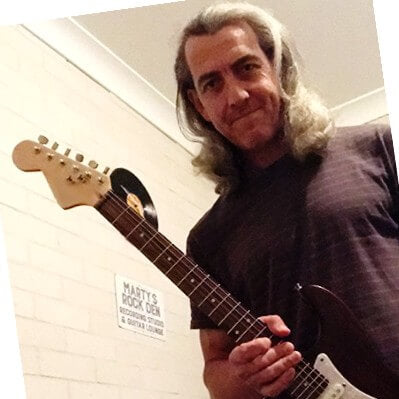Iconic Electric Guitars & How to Build Them: Part 1
If you look back over the history of the electric guitar, there are a number of iconic guitars that over time seem larger than life. Not only due to the famous artists who performed and recorded with them, or the music they produced, but also due to the aesthetics of the guitar itself.
I’m talking about guitars like Stevie Ray Vaughan’s ‘number one’, Brian May’s ‘Red Special’ – also commonly referred to as ‘The Fireplace’, Eric Clapton’s ‘Blackie’ and of course Eddie Van Halen’s ‘Frankenstrat’.
In the following article, we’re going to take a closer look at some of the most iconic electric guitars of all time and how, with the help of your own DIY kit guitar you can replicate these iconic designs yourself, from the comfort of your own home.
B.B King’s Lucille
The name B.B. King needs no introduction.
The ‘King of the blues’ was, without doubt, one of the most well-known and much-loved blues guitarists of all time, sadly passing away in May 2015.
Contrary to popular opinion, B.B. King’s ‘Lucille’ was the moniker given to a number of guitars the blues legend played throughout his long and illustrious career.

The guitar was originally named, after B.B. performing in a local dance hall had to make a quick escape after two men who were fighting (over a woman), knocked over the kerosene barrel that had been used for heating the hall. This started what B.B. once described in an interview as a ‘river of fire’ in the dance hall.
Once outside and realizing he had left his beloved Gibson 335® inside the hall, he bravely re-entered the now burning building to rescue the guitar.
According to B.B., he named the guitar (and every guitar he owned after that) after the woman the two men were fighting over, and who B.B. King apparently never even met as a reminder to never do anything so reckless again.
How to build your own Lucille:
As previously mentioned, there have been a number of Lucille’s over the years and as a result, there have been a number of subtle changes between subsequent models.
For instance, after 1982 B.B King’s ‘Lucille’ did not feature F-holes, unlike the standard Gibson ES 335®.
King also played ES 345’s® and his own signature model ‘Lucille’ built by Gibson® and in production from 1980 until 2015.
However, if wanting to build your own ‘Lucille’ your best bet is one of our 335 ES style semi-hollow body kits. Below are the custom options you will need to select:
- Mahogany body and neck
- White neck and body binding
- Block, Mother of Pearl (M.O.P) Inlays
- Gold Hardware
- Red/Pearl pickguard
- Plastic tone and volume knobs
Finishing:
Lucille features a black gloss finish, so there’s no need to highlight the grain of the timber, but being Mahogany you will need to grain fill the timber before painting due to the open pores of the timber.
You will also need to take care to either mask the binding prior to painting or scrape the binding using a razor blade once the finish is complete, which requires a degree of time and patience.
Level of difficulty:
For the most part, I’d recommend the 335 hollow body for more experienced builders. While the assembly itself is relatively straightforward (standard humbucker configuration and standard 2V, 2T, 3-Way Toggle electronics), the wiring must be threaded through the F-Holes and requires dexterity (along with patience) to fit the electrical components.
Being a set neck guitar, you will also need to take care with the position of the neck with regard to scale length and alignment.
Paul McCartney’s Höfner Bass®
Arguably the most famous bass guitar of all time, images of McCartney's left-handed Höfner® Bass are some of the most recognizable images in the history of popular music.
But, what you may not realize is McCartney actually started as a piano player and only picked up the bass when the original bassist (and central character in the Beatles' historical movie Backbeat) Stuart Sutcliffe left the band, leaving Paul to perform bass duties.

Upon Sutcliffe’s departure then 18-year-old McCartney (on tour in Hamburg, Germany at the time) required a bass guitar. After spotting a right-handed Höfner Violin Bass® in a local store in Hamburg, McCartney acquired the guitar for approximately $45 before switching the strings from right to left-handed, and the rest, as they say, is history.
How to build your own McCartney Violin Bass:
The Violin bass kit is based on the Höfner ‘Violin’ Bass and is as close to a replica of this iconic bass guitar as any you will find.
Choose the following custom options:
- Alder or Basswood body (the original Höfner Bass featured maple back and sides and spruce top)
- Rosewood neck with Mother of Pearl dot inlays
- White pearl pickguard
- Gold hardware
- Gold-tone and volume knobs
Finishing:
McCartney’s Höfner ‘Violin’ Bass® features a sunburst finish.
While not as simple as a standard solid color finish, you can create a sunburst finish using a number of different methods including the method outlined in our article on how to create a sunburst finish here.
Alternatively, if you have experience using spray cans or an air compressor, a sunburst finish of this nature can also be achieved freehand without the use of masking.
Level of difficulty:
Assembly of the violin bass kit is not difficult, especially if choosing a bolt-on neck. As the scale length and alignment is already taken care of for you.
The electronics are a little different to that of a standard electric guitar kit. The control panel closely resembles a circuit panel, which provides a more open layout and easier access for soldering.
If utilizing a ‘set neck’ some additional work is required, which you can read more about here.
Buddy Guy’s Polka Dot Strat®
If Muddy Waters is the undisputed king of the Chicago Blues scene, Buddy Guy would, without doubt, be considered Chicago blues royalty.
Buddy Guy’s credentials are hard to deny. A Grammy award-winning musician, renowned vocalist and remarkably versatile and innovative blues guitarist.
Guy blends elements of jazz, rock and traditional blues, creating his own signature style and still performing up to 180 shows per year while in his 80’s.

Guy, once the ‘house guitarist’ along with Muddy Waters on the now legendary ‘Chess Records’ label influenced a huge number of blues artists. This includes blues legends such as Eric Clapton and Stevie Ray Vaughan along with later day blues aficionados including John Mayer and Gary Clarke Jr.
Perhaps, an odd choice on the first appearance, the polka dots on Buddy Guy’s Strat® hold special significance to Guy who, before leaving for Chicago, convinced his mother he had a job lined up in the windy city (he didn’t) and that on achieving financial success would buy his mother a polka dot Cadillac.
While Guy did eventually find success and go on to become one of the finest bluesmen of his generation, his mother passed away before having the opportunity to see her son go on to become the renowned musician he is known as today.
How to build your own Polka Dot Strat®:
If you wish to replicate Buddy Guy’s iconic polka dot Strat®, you will first need to order an ST guitar kit and selecting the following custom options:
- Alder body
- Maple Neck
- Dot inlays
- Black Pickguard
- Chrome hardware
- Black tone and volume knobs
Finishing:
Buddy Guy’s ‘polka dot' Strat®’ features a black gloss finish. You can read our articles here on finishing techniques and finishing safety to achieve a similar finish.
Alder being a dense timber, compared to Mahogany, for example, will not require grain filling and can be sanded to a smooth finish soon after opening the box.
To recreate the iconic polka dot pattern I’d recommend either making your own or purchasing a ‘polka dot’ stencil pack, which can be found online. Just be sure to wrap the polka dot pattern around the contours and top and underside of the guitar as per the finish on Buddy Guy’s guitar.
Level of Difficulty:
ST guitar kits, are amongst the easiest kit guitars to assemble and make a great first DIY guitar kit for first time builders.
The electronics are mostly pre-assembled and pre-mounted on the underside of the pickguard. This means, your only requirement with regard to soldering is to connect the ground wire to the bridge, which grounds the signal and prevents unwanted electrical interference.
Summary
Building your own DIY guitar kit is a rewarding and enjoyable experience. Using a reference for selecting custom options and finishing is something I have always recommended to first-time builders and can provide a clear direction and take a lot of the guesswork out of the creative process.
Stay tuned, in our next article we’ll feature more iconic electric guitars, including Zakk Wylde’s ‘bullseye’ guitar along with Eric Clapton’s ‘Blackie’.

